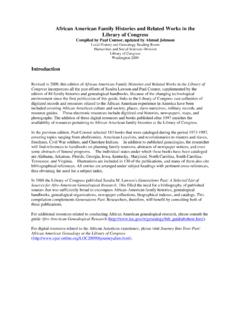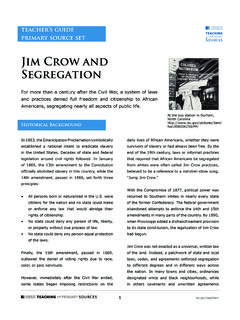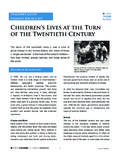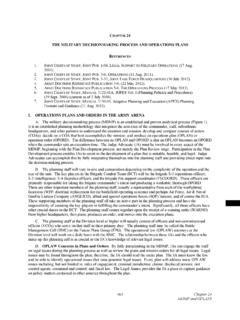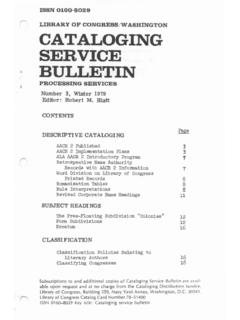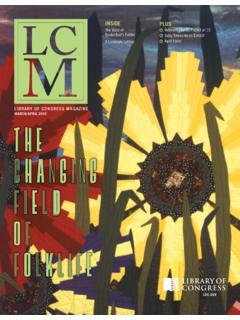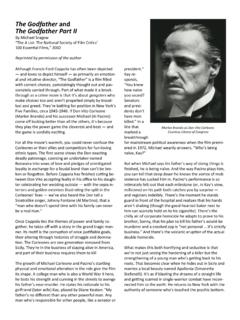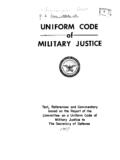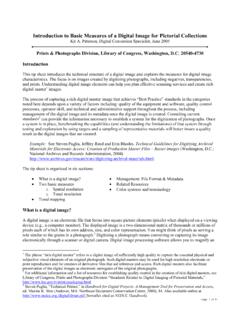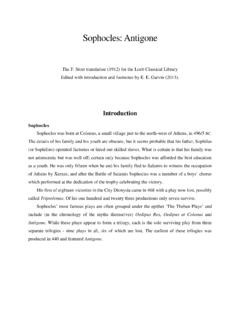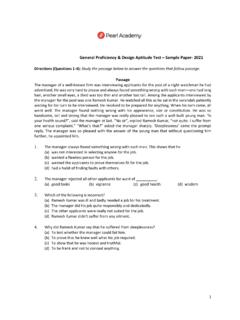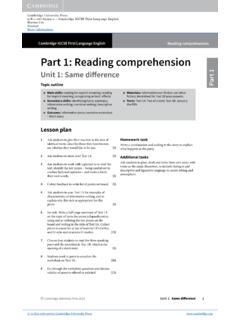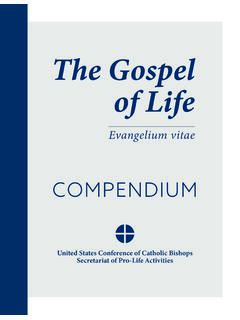Transcription of Lift Every Voice and Sing - Library of Congress
1 Lift Ev ry Voice and Sing --Manhattan Harmony Four (1923); Melba Moore and Friends (1990) Added to the National Registry: 2016 Essay by Burton W. Peretti (guest post)* James Weldon Johnson (left) and John Rosamond Johnson Few songs have captured as much of the sweep of US history as Lift Ev ry Voice and Sing. For over a century, like America the Beautiful or the Pledge of Allegiance, Lift Ev ry Voice has allowed its reciters to express and embrace the ideals and promise of the American experiment: Lift ev ry Voice and sing Till earth and heaven ring Ring with the harmonies of Liberty. Let our rejoicing rise, High as the list ning skies, let it resound loud as the rolling sea. Sing a song full of faith that the dark past has taught us. Sing a song full of the hope that the present has brought us.
2 Facing the rising sun of our new day begun Let us march on till victory is won. While this first stanza alludes to the dark past, it only in the second and third stanzas that the song reveals itself to be an anthem for African Americans: Stony the road we trod, Bitter the chast ning rod Felt in the day that hope unborn had died. Yet with a steady beat, Have not our weary feet Come to the place on which our fathers sighed? We have come over a way that with tears has been watered. We have come, treading our path through the blood of the slaughtered. Out from the gloomy past, till now we stand at last Where the white gleam of our star is cast. God of our weary years, God of our silent tears, Thou who has brought us thus far on the way Thou who has by thy might, Led us into the First sung in 1900, Lift Ev ry Voice is permeated with the legacy of slavery, only two generations gone, and haunted by the continued violent oppression of African Americans.
3 However, its final statement of patriotic loyalty-- May we forever stand/True to our God/True to our native land --also testifies to the almost boundless optimism of many black people at the beginning of the new century. The dialectic of hope and agony presented so memorably in this song remains central to the African American experience today. Lift Ev ry Voice and Sing was composed by two extraordinary men, James Weldon Johnson and John Rosamond Johnson. The brothers were natives of Jacksonville, Florida. James, two years older than John, gained a college education, taught school in rural Georgia and in Jacksonville, and became one of the South s first African American recipients of a law degree. Rosamond (as he was known) received training at musical conservatories in Boston and London, but also returned to Jacksonville to teach.
4 Both men worked at their alma mater, the Stanton School, Duval County s segregated black high school. James composed the poem Lift Ev ry Voice and Sing in 1899, and it became his first literary success. Rosamond set it to music for a performance at the Stanton School s Lincoln s Birthday assembly in 1900. The song might have remained a local curiosity if the Johnson brothers had not decided to relocate to New York City in 1901. Rosamond immediately found work there as a theater composer, and played a central role in the rise of African American musical theater to national prominence. James continued to co-write songs with Rosamond and the latter s new partner, the New York performer Bob Cole, launching pioneering Broadway stage musicals with all-black casts such as Shoo-Fly Regiment and Red Moon.
5 The restless elder brother returned for a time to Jacksonville, serving for a time as principal of the Stanton School, and was active as an attorney, novelist, and Republican Party organizer. James s political work resulted in his appointment by President Theodore Roosevelt to diplomatic posts in Venezuela and Nicaragua. Upon his return to New York in 1911, James became involved in the Harlem branch of the recently organized National Association for the Advancement of Colored People (NAACP). In the 1910s, hundreds of thousands of African Americans fled the South in search of better-paying jobs and less overt prejudice and segregation in northern cities. During the First World War, black communities rallied to the flag but also sought to ensure that the war to end all wars would nurture greater freedom and equality for them at home.
6 Music, literature, and other arts were put into the service of this movement and ignited the great Harlem cultural renaissance of the postwar era. Even as white America largely denied African Americans social progress after 1918, black writers and artists expressed both the joys of life and agonies of it under racism and gained unprecedented prominence. Early black migrants to Harlem, James and Rosamond Johnson were respected leaders of the postwar renaissance. James served as general secretary of the New York NAACP and became an outspoken figure for civil rights and against lynching. In 1920, his colleagues honored him by proclaiming Lift Ev ry Voice and Sing to be the Negro national anthem. This informal designation both reflected the song s popularity in African American schools, organizations, and churches, and ensured that it would take on new meanings as black migrants spread across the nation and extended campaigns for equal rights.
7 During the Jazz Age, the Swing Era, World War II, and the early Cold War years, dynamic new styles of African American popular song emerged, but Lift Ev ry Voice and Sing continued to be both a sentimental and a dignified favorite of black communities. As the performer and author Maya Angelou recalled, the composition was sung by her mostly black classmates at an Oakland middle school in defiance of discriminatory actions taken by white school officials. Lift Ev ry Voice and Sing was less prominent than other anthems during the Civil Rights Movement of the 1960s, but it nonetheless resonated at key gatherings in the North and South. Nelson Mandela s release from a South African prison in 1990 inspired the vocalist Melba Moore to film an all-star music video featuring the song.
8 Moore, Stevie Wonder, Dionne Warwick, Anita Baker, Bobby Brown, and a dozen other luminaries of soul and gospel music, dressed in white formal wear on a glittering stage, put a contemporary spin on the 90 year-old composition and introduced it to the MTV generation. The inauguration of Barack Obama as President of the United States in 2009 once again brought Lift Ev ry Voice and Sing to the attention of millions, as a message of multicultural hope and aspiration. During the often-troubled decade that followed, the song regained its militant force. In 2017, the carillon at the University of Florida rang out the melody in protest against the appearance of a white supremacist speaker on campus. In such ways, the Negro National Anthem as retained power and significance more than a century after its creation.
9 Burton Peretti is Dean of Liberal Arts and Sciences at College of the Siskiyous in Weed, California. He is the author of The Creation of Jazz, Jazz in American Culture, and Lift Every Voice : The History of African American Music. * The views expressed in this essay are those of the author and do not necessarily represent the views of the Library of Congress .
